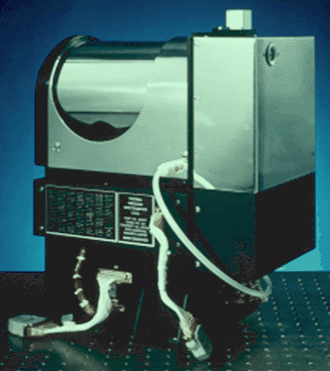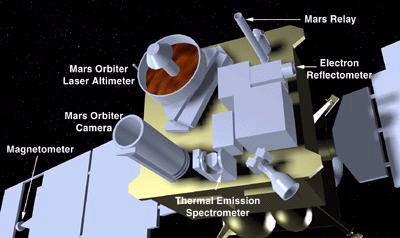
The Thermal Emission Spectrometer (TES)
Description of the Instrument
The TES instrument uses a Michelson interferometer (covering the thermal IR with a wavelength range from 6 to 50 microns (~1650-200 cm-1) with 5 and 10 cm-1 spectral sampling (~10 and 20 cm-1 resolution) to make infrared spectrometric measurements. Two sets of broad-band bolometric detectors cover the thermal (5.5 to 100 microns) and visible (0.3 to 2.7 micron) bolometric bands. Each sensor has six detectors arranged in a 3 X 2 array, each with a field-of-view of 8.3-mrad, translating to a spatial resolution of 3 km from the MGS orbit. In addition, the instrument has a rotating pointing mirror that allows it to take measurements from the nadir position up to and past the limb in both the fore and aft directions. Additionally, the pointing mirror can be positioned to take measurements of space, and of the internal reference surfaces and lamps contained within the body of the TES instrument. The TES onboard Data Editor aggregates the spectral data from the six detectors, in order to reduce the total amount of data to be downlinked (see specmask.pdf).
Reference
Christensen, P.R., Bandfield, et al. 2001. Mars Global Surveyor Thermal Emission Spectrometer experiment: investigation description and surface science results. JGR: Planets, 106(E10), pp.23823-23871.
Description of data
This dataset contains calibrated thermal IR radiance spectra and atmospheric and surface properties derived from this data. Also included are the parameters that describe the calibration functions for subsets of data. All TES spectrometer data (raw spectra) from original PDS data volumes were processed. The TES spectra in this archive were re-calibrated using new calibration algorithm that removes radiance artifact from the TES calibration functions and the observed spectra, and also accounts for the temperature dependence of the instrument response function (IRF). The details on the new re-calibration algorithm can be found in the User’s Guide document.
Location of Recalibrated Data
The data is in ASCII tables with detached XML labels. The six detectors are listed in sequence with time given in terms of the spacecraft clock (SCLK), which is defined as seconds since 12:00a.m. January 1, 1980.
Indices of the Individual Datasets
Accessing the Data
Citing the Data
Derived data products will be generated and archived in the same archive in the near future (April 2021).
 PDS: The Planetary Atmospheres Node
PDS: The Planetary Atmospheres Node



